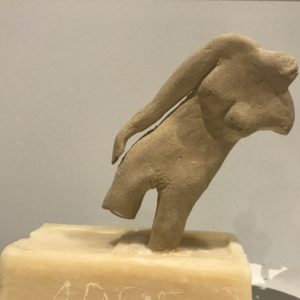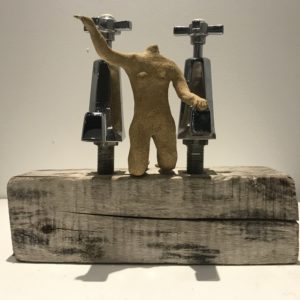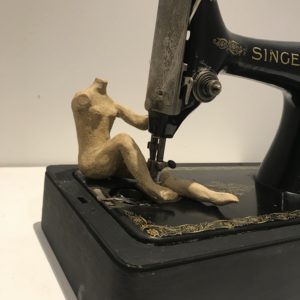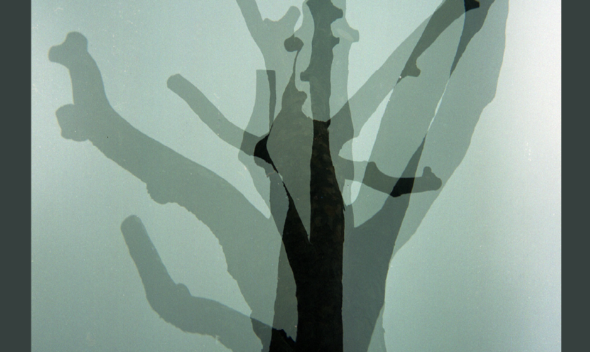The beautiful gallery space at Artcore seems to have been made for this installation of ‘Small Promethean Acts’. The circular room has a very high ceiling from which a circular glass mobile hangs in the centre. Eight small speakers hang from the ceiling in the middle at head height so that you can place them to your ear to hear recorded stories about small acts of care collected from the public in Derby. It is lit with a warm light from spots on the wall and there is light enough to see 20 or more small assemblage sculptures made from tiny stoneware figures that have been made to fit around found domestic objects.
Not all the work was made for this installation. Some existing work sits next to new work made from things found, mostly on the streets, during the residency – like a serving platter, a Ruskin bowl, a child’s hoover toy, plates, and a teapot. Others are older items that were found and kept over the years, like the singer sewing machine, an old typewriter, some taps, a string pot and a dustpan.
The sculptures are displayed on old white furniture of different sizes, used as plinths and arranged in a semi-circle ending in a snail shape that you enter to listen to the stories. They do not illustrate the stories, that are told quietly in a small hum that emanates from the speakers but create a performative aesthetic that creates a signifying practice that creates further conversations between objects and subjects. Made to disrupt and dramatise usual domestic stereotypes and marshall expected meanings into new ways of looking at home, and those that work there – for others.
From this room you can have a peek at the shared studio space and the remains of our working processes on the tables and walls. Sharing the studio and space with Natasha Joseph was fun and illuminating. Natasha Joseph is a young artist originally from Bangalore who is exploring notions of nationality, home and displacement through film, mapping and objects. Two months was not long enough to explore every part of her script and project ‘Home Struck’ yet she intimates the process beautifully through the texts. There are also some lovely collaborative overlaps that we found in our separate practices and these are marked by the floor text between the two spaces as well as the catalogue which was designed to be read front to back, and back to front and meet in the middle celebrating collusive colour, stories, and objects.
The residency has been a great opportunity in so many ways. Not just developing this project but investigating ways that I might make work with new audiences and communities when I return to Cornwall for another project ‘How to go from one page to another’.
I have also thoroughly enjoyed making. I worked late many nights making small stoneware figures, shaping, embodying, and pulling them around the objects; making them perform and gesture, to tell stories about themselves and the objects. I always make a head and a face not matter how difficult adding the detail to a face at the scale used (each figure is approx 15cm high, the head 3cm).
I don’t use many tools as I like using my hands and nails. I thought long and hard about why I often discard the heads and the figures end up fragmented. There is an ageless classic sculpture reference (humorously so because the figures are often quite quickly and clumsily made) yet it is also to do with ‘universality’.
One of the women at the workshop talked about ‘faceless’ dolls and made a figure that deliberately did not have a face. I am still reflecting on this. I’m not sure I want to make their faces blank, so making some of the figures without heads (and sometimes without all their limbs) seems to be fitting metaphors for ‘it could be you’, universality as well as fragmentation.
The installation hopes to represent and record small domestic acts of care in order to create value for ‘home workers’ – mostly women – and the work they do. At heart it is political yet hopes to aesthetically appeal to broad audiences.













Leave a comment